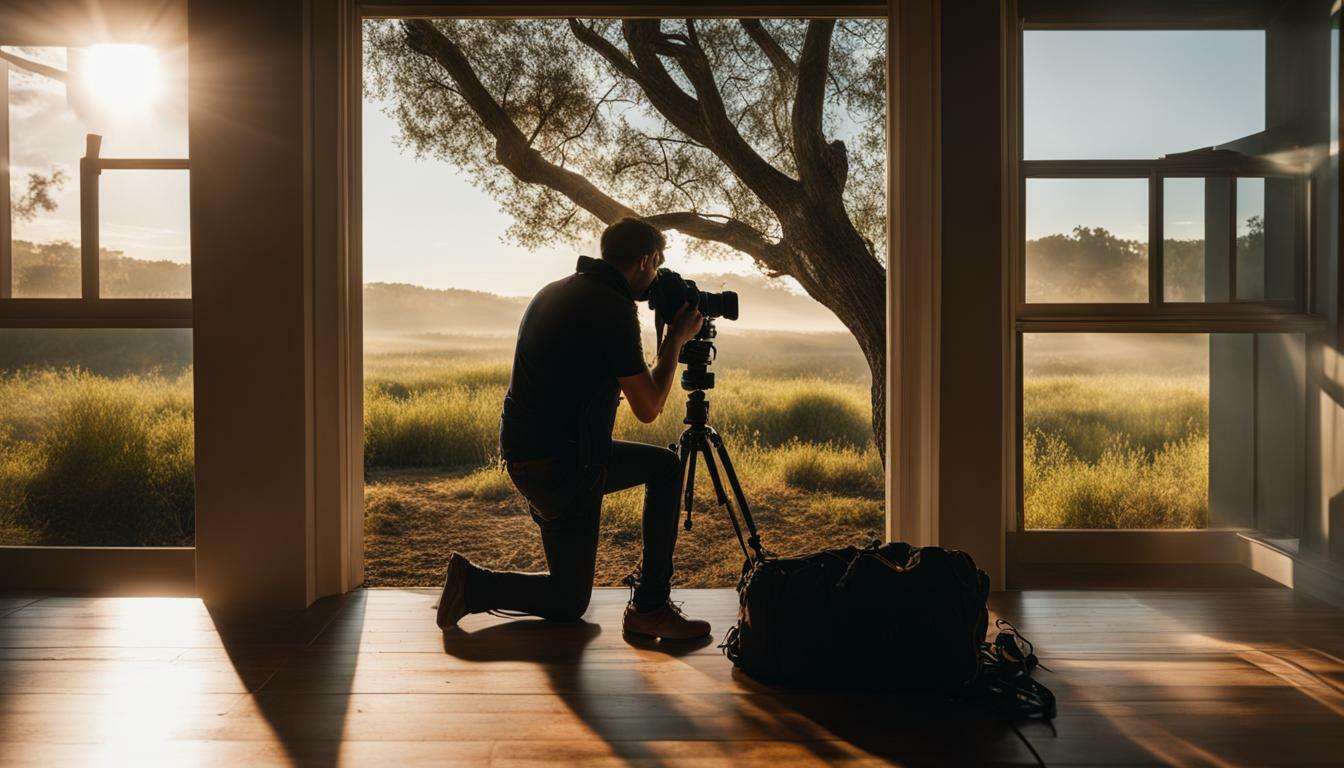Mastering exposure settings is essential for capturing well-balanced photos. Understanding exposure allows photographers to control the amount of light hitting the camera’s sensor, resulting in properly exposed images. By utilizing the exposure triangle – aperture, shutter speed, and ISO – photographers can fine-tune the exposure to achieve the desired effect. Additionally, the camera’s light meter provides valuable information on the exposure level, helping photographers make necessary adjustments for balanced exposure. In this section, we will delve into the importance of mastering exposure settings and provide insights on metering for correct exposure.
Key Takeaways:
- Understanding exposure is crucial for achieving well-balanced photos.
- The exposure triangle consists of aperture, shutter speed, and ISO.
- The camera’s light meter helps determine the exposure level.
- Adjusting aperture, shutter speed, or ISO can correct overexposed or underexposed photos.
- Mastering exposure allows photographers to have more control over their photos and achieve the desired effect.
The exposure triangle: Aperture, shutter speed, and ISO
The exposure triangle, consisting of aperture, shutter speed, and ISO, is used to control the amount of light hitting the camera’s sensor. Understanding how these three elements work together is crucial for achieving well-balanced photos. Let’s take a closer look at each component:
| Component | Description |
|---|---|
| Aperture | Aperture refers to the size of the lens opening. It affects the amount of light that enters the camera. A wider aperture (smaller f-number) allows more light, while a narrower aperture (larger f-number) lets in less light. Aperture also controls depth of field, determining how much of the image is in focus. |
| Shutter speed | Shutter speed determines how long the camera’s shutter remains open. It controls the duration of the exposure, affecting the amount of light that reaches the sensor. A faster shutter speed freezes action but allows less light, while a slower shutter speed captures motion blur but lets in more light. |
| ISO | ISO measures the camera’s sensitivity to light. A higher ISO (e.g. 800 or above) makes the camera more sensitive to light, allowing for better exposure in low-light situations. However, it also introduces more digital noise into the image. Lower ISO (e.g. 100 or 200) produces cleaner images but requires more light. |
By adjusting these exposure settings, photographers can achieve the desired level of light and create a well-exposed photograph. It’s important to note that each component affects not only exposure but also other aspects of the image, such as depth of field and motion blur. Balancing lighting and exposure requires understanding how these settings interplay and making appropriate adjustments to capture the desired effect.
Why is mastering the exposure triangle important?
Mastering the exposure triangle allows photographers to have more control over their photos. By understanding the relationship between aperture, shutter speed, and ISO, photographers can intentionally manipulate the exposure to achieve their artistic vision. Whether it’s capturing a fast-moving subject with a high shutter speed or creating a shallow depth of field with a wide aperture, knowing how to adjust these settings ensures that the photos accurately represent the photographer’s intent.
Additionally, mastering the exposure triangle is crucial for achieving well-balanced photos in different lighting conditions. By understanding how to adjust aperture, shutter speed, and ISO to correct for overexposed or underexposed photos, photographers can capture images that accurately represent the scene’s lighting and convey the desired mood or atmosphere.
In conclusion, the exposure triangle empowers photographers to take creative control over their images. By mastering aperture, shutter speed, and ISO, photographers can manipulate exposure to achieve well-balanced photos and bring their artistic vision to life.
Using the camera’s light meter for balanced exposure
By using the camera’s light meter, photographers can ensure that the exposure is balanced in the center. The light meter provides a visual representation of the exposure level, indicating whether the photo is overexposed or underexposed. When the light meter moves towards the plus sign, it indicates an overexposed photo, whereas movement towards the minus sign suggests an underexposed photo.
Understanding these meter readings is crucial for achieving well-balanced exposure. To correct an overexposed photo, photographers can adjust the aperture, shutter speed, or ISO to decrease the amount of light entering the camera. On the other hand, underexposed photos can be corrected by increasing the exposure settings to allow more light into the camera.
As photographers, it’s important to keep in mind that the light meter is just a guide and may not always provide the perfect exposure. Different lighting conditions can affect the accuracy of the meter readings. It’s essential to constantly evaluate the results and make adjustments as necessary, relying on your creative judgment.
Tips for metering for correct exposure:
- Use the spot metering mode to measure the exposure of a specific area or subject within the frame.
- Consider using the histogram feature in your camera to analyze the distribution of light and adjust the settings accordingly.
- Experiment with exposure compensation to fine-tune the exposure in challenging lighting situations.
- Take multiple test shots and review them on your camera’s LCD screen to ensure accurate exposure.
| Exposure Level | Meter Readings | Adjustment Required |
|---|---|---|
| Overexposed | Meter moves towards the plus sign | Decrease aperture, shutter speed, or ISO |
| Underexposed | Meter moves towards the minus sign | Increase aperture, shutter speed, or ISO |
Mastering exposure settings and metering for correct exposure is a fundamental skill for any photographer. It allows you to have greater control over the light and achieve the desired effect in your photos. By understanding the camera’s light meter and making necessary adjustments, you can capture well-balanced and visually appealing images.
Adjusting exposure settings for optimal results
Adjusting the aperture, shutter speed, or ISO can help to correct the exposure and achieve the desired effect in photography. The exposure triangle, consisting of these three elements, provides photographers with greater control over the amount of light hitting the camera’s sensor. By understanding how each component affects exposure, photographers can make necessary adjustments to capture well-balanced photos.
When faced with overexposed photos, where the image appears too bright, photographers can decrease the aperture size, increase the shutter speed, or decrease the ISO to reduce the amount of light entering the camera. On the other hand, underexposed photos, where the image appears too dark, can be corrected by increasing the aperture size, decreasing the shutter speed, or increasing the ISO to allow more light in.
In addition to adjusting exposure settings, photographers can also explore the concepts of high key lighting and low key lighting to create specific effects. High key lighting focuses on well-lit subjects against bright backgrounds, while low key lighting emphasizes dramatic shadows and contrasts. Achieving these effects requires careful exposure adjustments and the use of appropriate lighting techniques.
| Exposure issue | Adjustment |
|---|---|
| Overexposed photos | Decrease aperture size, increase shutter speed, or decrease ISO |
| Underexposed photos | Increase aperture size, decrease shutter speed, or increase ISO |
Key Tips for Balancing Lighting and Exposure
- Take multiple test shots and review the histogram to ensure proper exposure.
- Consider using exposure compensation to fine-tune the exposure settings.
- Experiment with different lighting conditions and settings to achieve desired effects.
- Do not solely rely on the camera’s light meter; trust your eyes and intuition as well.
By mastering exposure settings, photographers can elevate their craft and capture stunning images that truly reflect their artistic vision. Understanding the exposure triangle, adjusting aperture, shutter speed, and ISO, and experimenting with different lighting techniques are all key factors in achieving optimal exposure. With practice and patience, photographers can create well-balanced photos that leave a lasting impact.
Maximizing natural lighting and utilizing artificial lighting setups
Lighting plays a crucial role in exposure, and in this section, we will explore techniques for maximizing natural lighting and utilizing artificial lighting setups. Understanding how to effectively use both natural and artificial lighting can greatly enhance the quality of your photos.
When it comes to natural lighting, there are a few key tips to keep in mind. First, consider the direction of the light. Side lighting can create depth and texture, while front lighting can minimize shadows. Backlighting can create a dramatic effect, especially during golden hour when the sun is low on the horizon. Experimenting with different directions of natural light can yield stunning results.
Intensity is another important factor to consider. The brightness of the sunlight can vary throughout the day, so pay attention to how it affects your subject. Shooting in the early morning or late afternoon when the light is softer can result in more pleasing and flattering photos.
Additionally, the quality of natural light can greatly impact your photos. Diffused light, such as on an overcast day, creates soft and even lighting. This is ideal for portraits as it minimizes harsh shadows. On the other hand, direct sunlight can create more contrast and drama. By understanding the qualities of natural light, you can choose the right time and conditions to maximize its impact on your photos.
Utilizing artificial lighting setups
To further enhance your exposure, it’s important to harness the power of artificial lighting setups. This allows you to have greater control over the lighting conditions, especially in situations where natural light may be limited or insufficient.
When using artificial lighting, one popular setup is the three-point lighting system. This involves using a key light, a fill light, and a backlight to create dimension and depth. The key light is the main source of illumination, while the fill light softens shadows, and the backlight adds separation between the subject and the background. By positioning the lights correctly, you can achieve a well-balanced and flattering exposure.
Furthermore, using the right lighting equipment is crucial for achieving optimal exposure. This can include studio lights, reflectors, diffusers, and modifiers to manipulate the intensity and quality of the light. Experimenting with different lighting setups and equipment can open up a world of creative possibilities and help you achieve the desired effect in your photos.
| Natural Lighting Tips | Artificial Lighting Setups |
|---|---|
| Consider the direction of the light | Utilize the three-point lighting system |
| Pay attention to the intensity of the sunlight | Use the right lighting equipment |
| Understand the quality of natural light | Experiment with different lighting setups |
To sum up, mastering exposure settings involves not only understanding natural lighting techniques but also utilizing artificial lighting setups effectively. By maximizing the potential of both types of lighting, photographers can elevate their photos and achieve well-balanced exposure.
Conclusion
In conclusion, mastering exposure settings is essential for capturing well-balanced and striking photos. The exposure triangle, consisting of aperture, shutter speed, and ISO, is a powerful tool that allows photographers to have precise control over the amount of light hitting the camera’s sensor.
By utilizing the camera’s light meter, photographers can ensure that the exposure is perfectly balanced. The light meter provides a visual representation of the exposure level, helping photographers determine whether their photos are overexposed or underexposed. Adjusting the aperture, shutter speed, or ISO can help correct any exposure issues and achieve the desired result.
Understanding and utilizing the exposure triangle not only allows photographers to have more control over their photos, but it also enables them to explore various lighting techniques and achieve different effects. Whether it’s capturing a beautifully lit landscape or creating dramatic low key portraits, mastering exposure settings is crucial for unleashing the full creative potential of photography.
So, whether you are a beginner or an experienced photographer, don’t underestimate the power of mastering exposure settings. Continuously learning and experimenting with exposure settings, along with maximizing natural lighting and utilizing artificial lighting setups, will elevate your photography to new heights and help you capture stunning, well-balanced photos that truly stand out.
How Does Negative Space in Photography Help Create Well-Balanced Photos?
Negative space in photography is the area surrounding the main subject. By incorporating negative space effectively, photographers can create well-balanced photos that draw attention to the subject. This technique allows the subject to stand out and emphasizes its importance within the composition. By consciously leaving empty areas, photographers can also evoke emotions, provide context, and enhance the overall visual impact of the image.
How Does Understanding Exposure Settings Help with Cinematography?
Understanding exposure settings is crucial in cinematography, as it directly impacts the overall look and feel of a film. Properly manipulating exposure allows filmmakers to control the brightness, contrast, and depth of their images, enhancing storytelling in three areas in cinematography: lighting, composition, and mood. By mastering exposure settings, cinematographers can effectively communicate emotions, emphasize important details, and create visually stunning scenes that captivate audiences.
FAQ
Why is mastering exposure settings important for capturing well-balanced photos?
Mastering exposure settings allows photographers to control the amount of light hitting the camera’s sensor, ensuring that their photos are properly exposed and well-balanced.
What is the exposure triangle?
The exposure triangle consists of aperture, shutter speed, and ISO. These three elements work together to control the amount of light that enters the camera.
How can I use the camera’s light meter for balanced exposure?
The camera’s light meter provides a visual representation of the exposure level. By interpreting the light meter readings, photographers can make adjustments to achieve the desired exposure.
How can I adjust exposure settings to achieve optimal results?
Adjusting aperture, shutter speed, and ISO can help correct overexposed or underexposed photos. Understanding high key and low key lighting techniques is also important for achieving desired exposure.
How can I maximize natural lighting and utilize artificial lighting setups for better exposure?
Tips for maximizing natural lighting include understanding the direction, intensity, and quality of light. Utilizing artificial lighting setups and appropriate lighting equipment can provide greater control over exposure.






